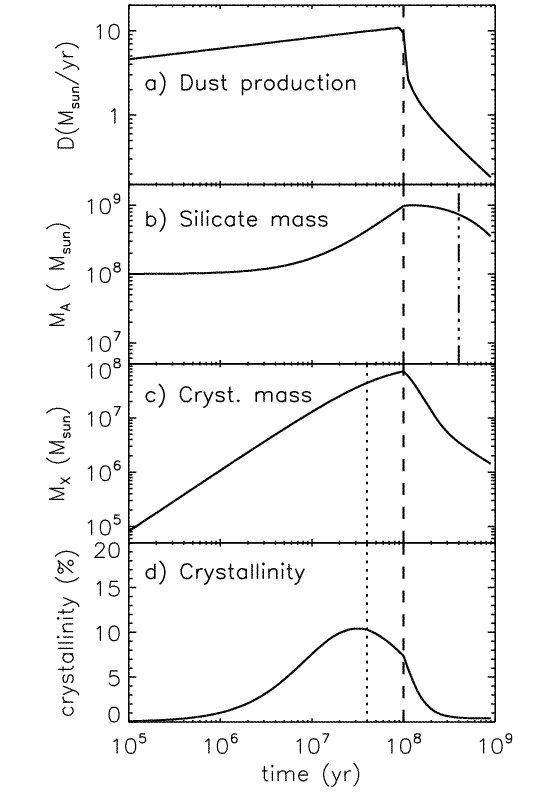Research Gallery > Interstellar and Circumstellar Medium
Research Gallery
Interstellar and Circumstellar Medium
| The crystalline fraction of interstellar silicates in starburst galaxies |
|
Image Credit: Kemper et al. 2011, MNRAS 413, 1192

The top panel indicates the total dust production in a starburst galaxy in terms of time after the start of the starburst; the star formation rate is constant and the starburst lasts 100 million years (indicated by the dashed line). The amorphization time scale is indicated by the dotted line, and the destruction time scale by the dash-dotted line. The resulting total silicate mass is shown in panel b) and the crystalline silicate mass is shown in panel c). Dividing these two quantities yields the crystalline fraction, or crystallinity, plotted in panel d), and it is apparent that under certain circumstances a high crystalline fraction may indeed occur in the interstellar medium of starburst galaxies
|
| Most of the dust in the interstellar medium in our own Milky Way consists of silicates in a glassy, or amorphous, appearance. This is also shown to be the case in most external galaxies, and it is thought that processes such as cosmic ray hits, and interstellar grain growth, cause essentially the entire silicate reservoir to be amorphous. However, a few years back it was shown that some galaxies undergoing a burst of star formation, the so-called starburst galaxies, actually show a considerable fraction of their interstellar silicate mass in crystalline form. Crystallization of silicates occurs in relatively high temperature environments (1000-1500 K) usually only found in the dust producing environments of evolved stars, and indeed, a small but measurable fraction of crystalline silicates is often seen around evolved stars. It was argued that in starburst galaxies so much dust production was taking place by massive stars with relatively short life spans, that the crystalline signal from this dust was drowning out the amorphous signal from the interstellar medium. |
 asiaa.sinica.edu.tw Media Request: epo
asiaa.sinica.edu.tw Media Request: epo asiaa.sinica.edu.tw
asiaa.sinica.edu.tw 
